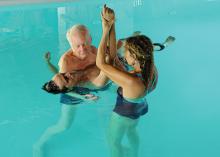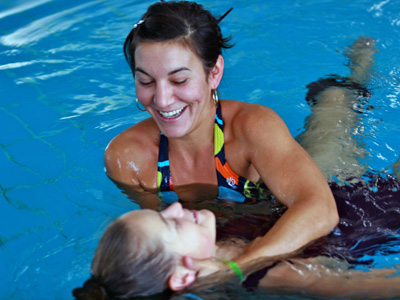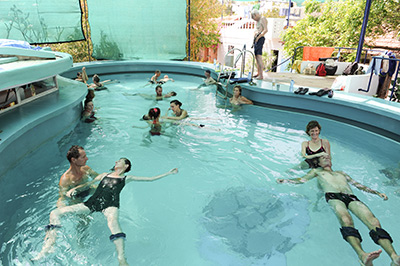
In 1980, at Harbin Hot Springs in Northern California, I floated someone in a warm pool and applied the stretches and principles of the land-based Zen shiatsu I had learned years earlier with its creator, Shizuto Masunaga, in Japan. I had no idea that what was coming into being that night would help millions of people of all ages in spas, clinics, and backyard pools around the world, and would become a new way to bring people together to come to know and celebrate their connection.
The Stretch
In Zen shiatsu, Masunaga teaches that stretches are an older way to access and balance the flow of energy through our bodies than shiatsu’s traditional work with acupuncture points. Stretching increases flexibility, and warm water—which many associate with the body’s deepest states of waking relaxation—is the ideal medium for it. The support of water takes weight off the vertebrae and allows the spine to be moved in ways impossible on land. Gentle, gradual twists and pulls relieve the pressure a rigid spine places on nerves and helps undo any dysfunction this pressure can cause to the organs served by those nerves.
In Watsu, the receiver experiences greater flexibility and freedom, while a range of emotions can come forward and be released into the process of continuous flow. For both giver and receiver, this work in the water helps us face life out of the water with greater equanimity and flexibility.

The Breath
In the beginning, Watsu was all about stretching—using our physical closeness to brace powerful stretches and be moved around the pool by the energy those stretches released. Stretches, and the closeness that facilitates them, will always be important in Watsu, but in its first years of development, another element moved to the forefront—the unique connection to the breath that our closeness in water also facilitates.
In water, where the buoyancy lifts our body every time we breathe, our whole body breathes. We begin a Watsu session doing nothing, settling into the water, holding a client with one arm under their head, the other arm under their body. When we feel them getting lighter on that arm as they breathe, the therapist’s breath is drawn up. Then, we drop back into the emptiness at the bottom of the breath and do nothing. Being drawn up out of that emptiness again and again, up through our core in this waterbreath dance, engages our whole body and establishes a connection that continues through our moves and stretches born in that rhythm.
The closeness, developed out of necessity when Watsu first came into being because no flotation devices had yet been developed to keep clients fully above water, is still an essential part of the work. Even with the advent of various float devices we use with Watsu today, it’s the closeness between giver and receiver that distinguishes Watsu from subsequent forms of aquatic bodywork where practitioners float clients at a distance.
Being held accesses an innate level of healing. When infants fall, a mother’s response is to pick them up and hold them. Containment creates safety. It allows us to go deeper within and access every level of our being. It is a cornerstone of Watsu.
The Outcome
Ultimately, Watsu is about adaptation. Sharing Watsu with someone means respecting their limits and adapting to whatever is called for. Watsu allows for the form to evolve and adapt each session, as creativity and authentic movement come into play.
Watsu’s unique power to reduce stress has made it a treatment of choice in spas around the world. Many come out of a session saying it is the most relaxed they have ever been in their lives. Watsu can provide relief from almost any condition related to stress—physical or mental. And the anecdotal and research-based evidence surrounding the efficacy of Watsu continues to grow.
- Kathy Bateman, who managed the pool at the Children’s Hospital in Seattle, says she has seen Watsu benefit children who are paralyzed, stroke patients, those with cerebral palsy, and terminally ill patients.
- Practitioners around the world find that Watsu benefits pregnant women. Throughout the pregnancy, Watsu can help bond mother and child even before the birth, as the water creates a shared energy. From a physiological perspective, Watsu soothes muscles that are challenged with pregnancy’s rapid weight gain. Some practitioners claim that their clients’ babies turned out of breech position in the nights and days following Watsu.
- Tomasz Zagorski, a sports therapist and Watsu instructor who has successfully brought aquatic bodywork into the programs of sports teams and Olympic medal winners, says Watsu for athletes has become a new field of application. Watsu’s ability to accelerate the body’s regeneration process makes it a valuable tool in the athlete’s recovery after intense competition and training sessions. Besides increasing joints’ range of motion, Watsu provides an opportunity to stretch muscles in combinations of directions and planes unworkable on land.
- Additional studies include Watsu’s benefits for fibromyalgia, chronic back pain, and trauma, as well as helping veterans with PTSD.1

The Future
The beauty of Watsu is that it continues to evolve. From water to land, from couples to communities, Watsu adapts and grows in its ability to connect. The boundlessness felt in warm water is the sheath of prana, the warmth within, becoming one with the warmth of the water. During Watsu, when our minds’ chatter becomes most stilled, the more spontaneous and intuitive our moves become, the more they are coming out of our bodies’ innate wisdom, and the deeper we move into rapture. It is said that once an opening is made to the rapture, once we know how to access it, we will be able to see it underlying even the greatest of our sorrows. I can imagine no better goal for Watsu than to help people realize a level of consciousness from which they can face anything—a level as boundless as water.
Note
1. K. Faull, “A Pilot Study of the Comparative Effectiveness of Two Water-Based Treatments for Fibromyalgia Syndrome: Watsu and Aix Massage,” Journal of Bodywork and Movement Therapies 9, no. 3 (2005): 202–210. doi: 10.1016/j.jbmt.2004.12.001; S. J. Smeeding et al., “Outcome Evaluation of the Veterans Affairs Salt Lake City Integrative Health Clinic for Chronic Pain and Stress-Related Depression, Anxiety, and Post-Traumatic Stress Disorder,” Journal of Alternative and Complementary Medicine 16, no. 8 (2010): 823–835. doi: 10.1089/acm.2009.0510.




